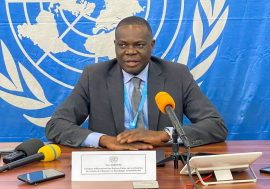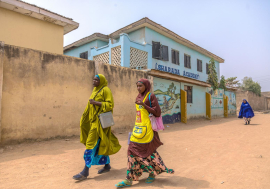How to boost trade within Africa
How to boost trade within Africa
Only a few hundred kilometres separate Lagos, Nigeria, from Accra in Ghana. For the thousands of traders who ply this route, the journey through Togo and Benin can take a full day, punctuated by arduous border checks, harassment and solicitations from officials for kickbacks.
"Customs officials and police at roadblocks will make you unload and unpack every little package in order to delay you for hours," says Ms. Lucia Quachey, secretary-general of the African Federation of Women Entrepreneurs, an organization of more than 4 million women across the continent, producing and trading everything from textiles to pharmaceuticals and vehicle parts. "Everyone knows the intention is to force travellers to pay."
Some of this activity is illegal, she says -- deliberate efforts by officials to violate the principle of free movement of people and goods within the 15-member Economic Community of West African States (ECOWAS). It is also due to the slow implementation of regional integration agreements aimed at eliminating tariff and non-tariff barriers in the region. Despite pronouncements of support by politicians for regional economic ties, the reality on the ground for traders such as Ms. Quachey remains difficult.
African countries are grappling to undo a legacy dominated by trade with their former colonial rulers rather than with each other. Senegal's biggest trading partner is France, while Gambia trades extensively with the UK. Although Senegal surrounds Gambia, trade between the two neighbours is minimal.
The continent's railways and roads often lead towards the ports rather than link countries across regions. To fly from one African country to another, it is often easier to pass through Europe. Relatively lower tariffs on African goods entering European Union and US markets also make export to industrial countries more lucrative than to other African countries. Because of hindrances to trade within Africa, exports from Tunisia and Cameroon often find their way to French warehouses before being redirected to each other's market shelves.

Producing more textiles and other manufactured goods can stimulate trade among African countries.
Photo : ©UNIDO
To boost trade among African countries, regional economic communities (RECs), such as ECOWAS, have been created over the last few decades. Trade among African countries only accounts for about 10 per cent of their total external trade (see graph), the lowest of any world region, notes the Addis Ababa-based UN Economic Commission for Africa (ECA) in its 2002 Annual Report on Integration in Africa. The challenges of improving such low levels of intra-African trade are immense, but policymakers on the continent are increasingly focusing on them as a new wave of interest in regional integration gains momentum.
A few countries, a few products
Experts acknowledge that for African countries to be able to capture more trade opportunities they need to diversify their products. At present, regional economic arrangements "exhibit narrow patterns of trade, depend on primary products and involve low levels of inter-country trade," says Mr. William Amponsah, an associate professor of international trade and development at North Carolina State University in the US. Since most African countries produce and export raw materials, not processed goods, there is little that they are interested in importing from each other.
Intra-African trade is dominated by a handful of countries, selling a handful of products. In sub-Saharan Africa (excluding South Africa) five countries -- Côte d'Ivoire, Ghana, Kenya, Nigeria and Zimbabwe -- provide about three-quarters of all intra-African exports, the World Bank reports. Of key importance to this trade are primary products. Petroleum alone accounts for more than 30 per cent of this exchange, and cotton, live animals, maize and cocoa add a further 18 per cent. To a lesser extent, fresh fish, vegetables, tea and sugar are also traded. Manufactured goods account for only about 15 per cent of such activity, notes a recent World Bank study, What Can Be Expected from African Regional Trade Arrangements? These include yarn, medicines, iron and steel, chemicals and industrial machines and equipment.
For individual countries, a few commodities often make up the bulk of exports to the rest of the continent. In Angola, for example, petroleum and petroleum products make up more than 90 per cent of exports to other African countries. In the Seychelles, fresh fish constitutes nearly 98 per cent of such exports. Because of very limited diversity of products, the same primary products also tend to dominate Africa's trade with the rest of the world, notes the author of the World Bank study, Mr. Alexander Yeats.
More open trade
Current efforts at regional integration date back to 1994 when the Abuja Treaty, acceded to by members of the then-Organization of African Unity, took effect. The treaty calls for a phased approach to integration culminating in the establishment of an African Economic Community. The first stage was to involve the elimination of tariffs on goods traded within the various regional economic communities to create free trade areas. Non-tariff barriers would also be eliminated and a common external tariff adopted to form a customs union. Higher trade taxes on the continent compared to other regions are among the factors discouraging trade among African countries.
The phased approach outlined in the Abuja agreement, such as reducing tariffs selectively at a regional level, has been implemented only in parts of a couple regions. To a great extent, it has been superseded by the type of across-the-board trade liberalization promoted through the structural adjustment programmes financed by the World Bank and International Monetary Fund (IMF).
Africa's informal sectors are "larger, more dynamic and more regionally integrated" than the official economies.
Photo : ©Impact Visuals / Wim van Cappellen
In 1990, the IMF classified 75 per cent of countries in sub-Saharan Africa as having "restrictive" trade policies. Now, only 14 per cent are still considered restrictive. The situation is still far from ideal, notes the IMF, as average tariffs of 19 per cent in Africa are still higher than the 12 per cent average in the rest of the world. The IMF recommends further liberalization if the continent is to avoid marginalization from global trade.
African tariffs on raw materials such as fibres remain high. Taxing key inputs for labour-intensive industries like clothing and textiles, which Africa has a comparative advantage to produce and export, is counter-productive, the World Bank notes. High tariffs on fertilizers, pesticides and agricultural chemicals constitute "an important disincentive to local production for export," notes the Bank study. Tariffs on essential inputs in farm production such as fertilizers (produced by a number of African countries) average four times those imposed in Southeast Asia.
What about production?
While reducing some tariffs may make sense, critics of liberalization point out that the narrow focus on sweeping tariff reduction over the last two decades has neither increased trade nor boosted production. Before structural adjustment took hold in Africa, many governments sought to industrialize their economies through policies of import substitution. In other words, they used trade measures -- such as charging high tariffs on imports of goods produced domestically -- to encourage the local manufacture of these products. But structural adjustment and the advent of World Trade Organization rules governing global trade have precluded such policies.
Where current economic development policies are leading still remains unclear, notes a study by Yilmaz Akyüz and Charles Gore of the UN Conference on Trade and Development (UNCTAD). What is certain, however, is that across Africa many incentives to promote industrial development have been dismantled through structural adjustment, the study notes. "The immediate impact has been widespread de-industrialization." While in 1980 there were 14 countries in sub-Saharan Africa with per capita manufacturing production comparable to Indonesia, by 1995 these countries had all been overtaken by that Asian nation, according to the UNCTAD study. In Ghana -- a star performer of structural adjustment -- employment in the manufacturing sector fell from a peak of 78,700 in 1987 to 28,000 by 1993. Large sections of the country's manufacturing industry were devastated by the removal of tariffs and state supports, as cheaper imports from outside Africa eroded their competitiveness, the UNCTAD study notes. What is more disturbing, Akyüz and Gore say, is that Ghana's potential to manufacture and export garments, footwear, toys and other light consumer goods cannot be realized in the face of stiff external competition. "There is a need for a more active state role than permitted under adjustment programmes," so as to better support African industrialization.
Nurturing the small-scale sector
As African countries pursue more trade opportunities, they will also require a dynamic private sector to play a role. In many African countries the private sector is often made up of a few giant multinational corporations at one end and a large but small-scale informal sector at the other. One of the challenges facing African policymakers is how to deal with a small-scale sector that is responsible for a significant portion of production, trade and services.
While the informal sector is "the driving force of most economies in Africa, it is largely unregulated, has little access to finance, is often not taxed and its contribution to the economy is largely unrecorded," says Ms. Adelaide Mkhonza, an assistant secretary-general at the African, Caribbean and Pacific Group of States (ACP), a trading and aid bloc linked with the European Union. Africa cannot continue to ignore this sector if integration is to succeed, notes Ms. Mkhonza. A major critique of current regional integration efforts in Africa is that their design and objectives are driven by a preference for formal rather than informal trade. Ms. Mkhonza views the sector as an effective means of integration from below, as small-scale trade is often conducted and driven by the needs of indigenous traders rather than governments or international agencies.
"There is a real economic integration going on at the informal level," concurs the non-governmental InterAfrica Group (IAG). For many years it has been recognized that many countries' real economies "have been mostly informal and much larger, more dynamic and more regionally integrated than their official economies."
African countries are grappling to undo a legacy dominated by trade with their former colonial rulers rather than with each other.
But in the past, informal trade among African countries was often viewed as synonymous with smuggling. Small-scale, cross-border traders were seen as seeking to exploit differences in national pricing policies, mainly on agricultural goods. The informal sector sometimes was also associated with corruption, violent conflict and drug trafficking, and therefore was not actively promoted through government policies. In an era of state monopolies, anything beyond government control was deemed a potential political threat.
It is only during the last two decades that African countries have begun to place a higher priority on trade with each other, reports the African Development Bank (ADB), and in the process are increasingly viewing the informal sector as a partner. In its 2002 Annual Report on Integration in Africa, the ECA points to the recently reconstituted East African Cooperation (formerly the East African Community) as an example of a regional trade bloc beginning to incorporate the informal sector into its activities and policies. This is attributed to the realization of the significance of the cross-border activities taking place in Kenya, Uganda and Tanzania, the three members of the community.
In a recent joint statement, the community's three presidents, Daniel arap Moi, Yoweri Museveni and Benjamin Mkapa, pledged to focus on areas that would have the greatest impact on poverty reduction, such as infrastructure provision, cross-border trade and the promotion of the informal sector.
To mobilize all the resources Africa requires for effective integration, says ECA Executive Secretary K.Y. Amoako, "we must broaden our perception of the private sector to include ordinary citizens, staple food growers, cash crop farmers, taxi drivers, small enterprise owners, traders and street vendors."
Encouraging investment
To enhance intra-African trade, countries also will need to attract the private sector -- both domestic and foreign -- notes Mr. Cyril Enweze, former vice-president of the ADB. Respect for the rule of law and clear, consistent and predictable macro-economic policies are prerequisites for a suitable business environment, Mr. Enweze told Africa Recovery.
"It is no secret that the African continent is perceived as one in which there is so much turbulence, war, civil disturbance, civil strife, confusion, political instability and so on," he says. And in many developing countries the lack of credible macro-economic policies keeps industry away. Policies change too frequently and so "businessmen do not know, from one day to the other, one week to the other or one month to the other, exactly what is going to happen."
Another missing ingredient in the formula is an efficient transport and communications system. Poor infrastructure is a major cause of Africa's low competitiveness, notes Mr. Enweze.
For every 100 people in Africa there are 1.2 telephone lines -- the lowest rate in the world. Telephone calls between African countries can be 50-100 times more expensive than they are within North America, according to the World Bank, while freight costs for imports to landlocked African countries are more than twice as high as in Asia. In order to allow trade to flow regionally, investment in physical infrastructure -- roads, railways, power lines, air services and telecommunications -- is necessary.
Ultimately, the benefits of creating regional markets in Africa are many. Integration would enhance industrial efficiency as larger markets allow exploitation of economies of scale, notes Prof. Amponsah of North Carolina State University. Mobility across borders and harmonized policies could spur faster economic growth and provide greater opportunities to attract investors.
"Regional trade agreements can help countries build on their comparative advantages, sharpen their industrial efficiency, and act as a springboard to integrate into the world economy," he says. A more open continent will "build credibility for Africa's best reformers in the eyes of the world and, hopefully, reward them with greater access to markets."























